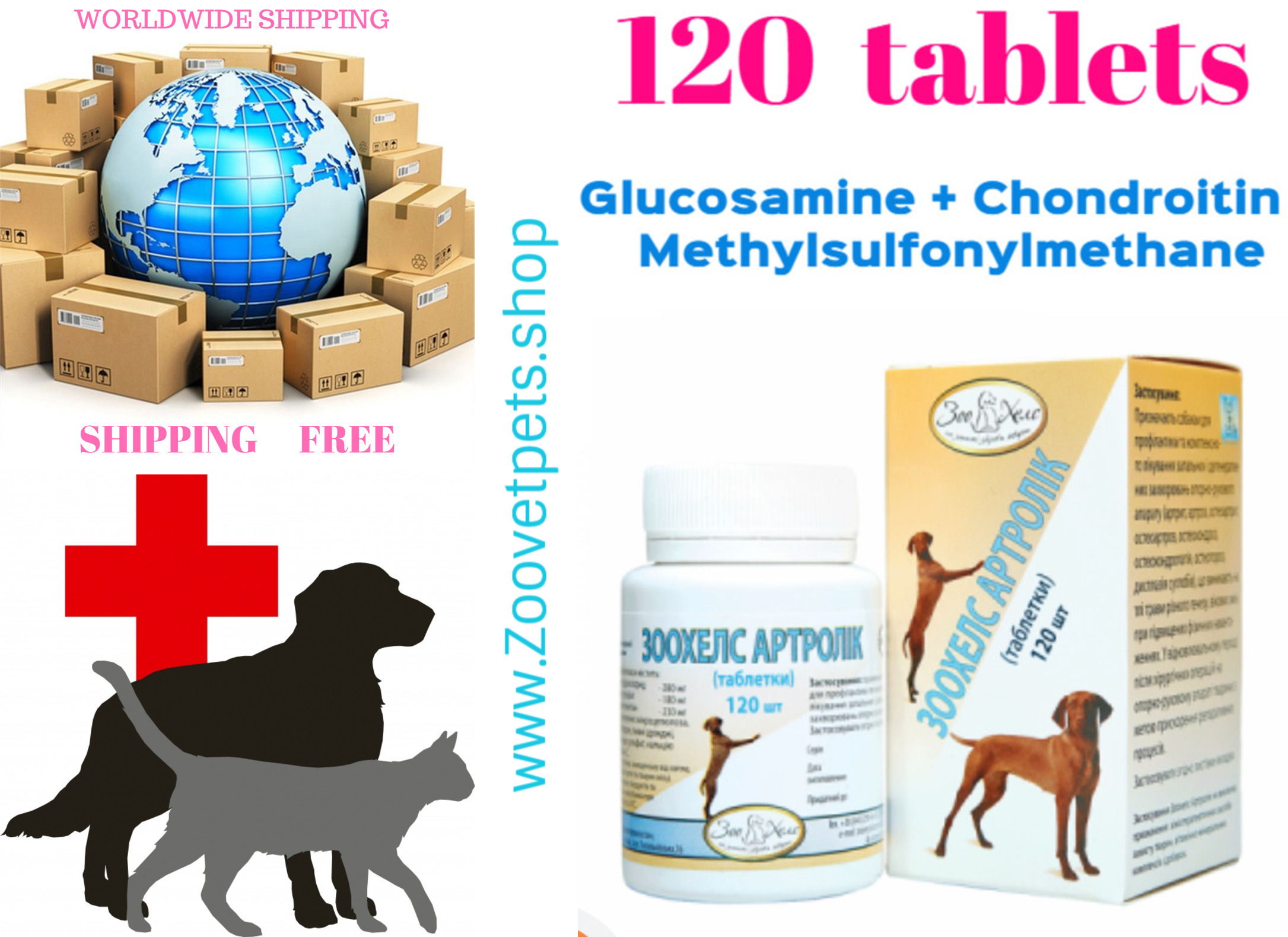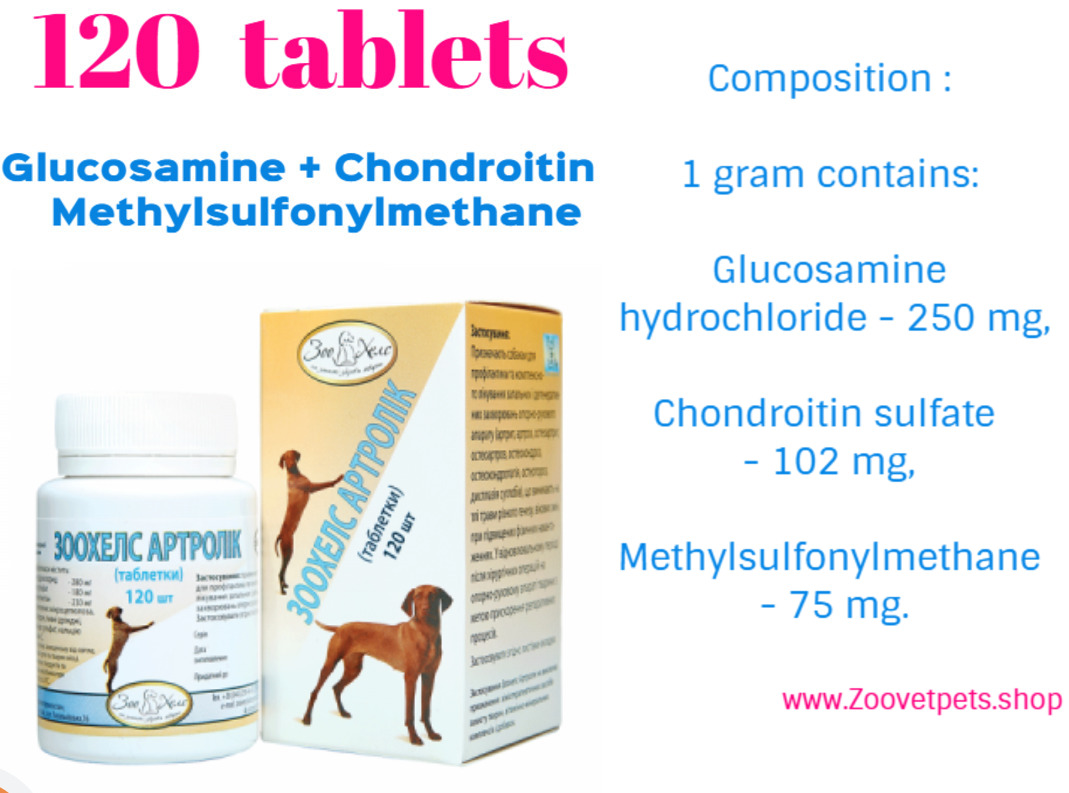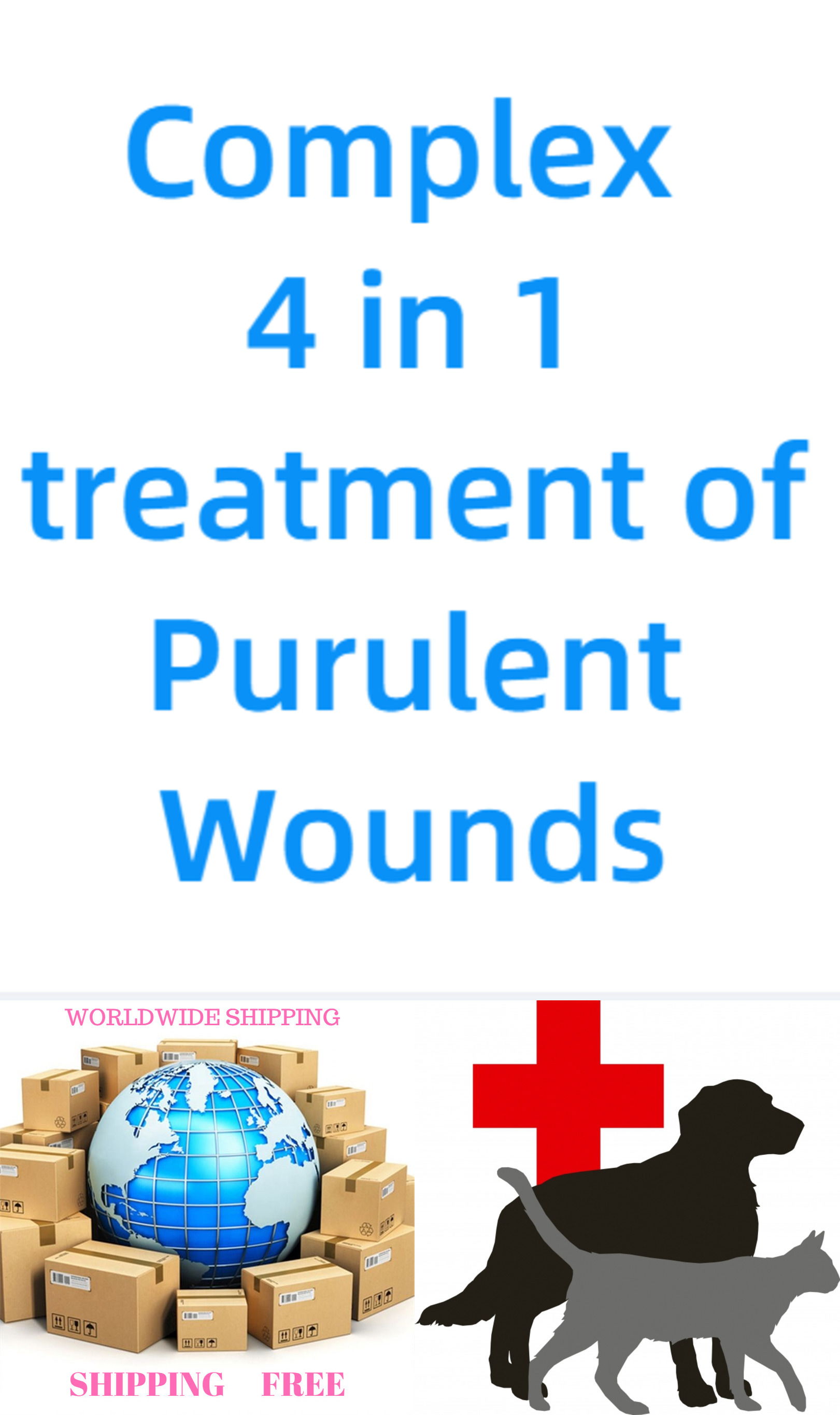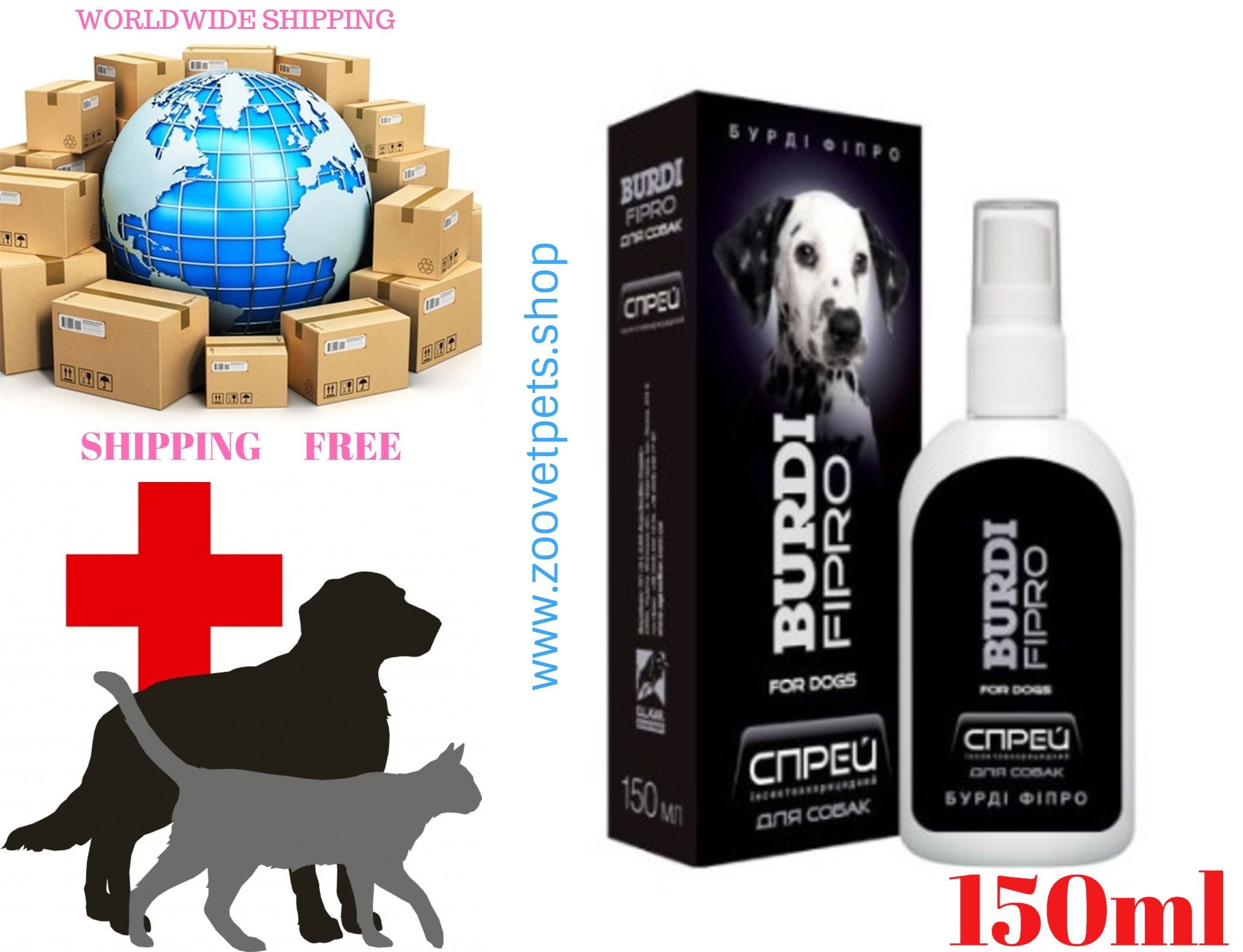Description
Composition :
1 gram contains:
Glucosamine hydrochloride – 250 mg,
Chondroitin sulfate – 102 mg,
Methylsulfonylmethane – 75 mg.
Excipients: microcellulose, polyvinylpyrrolidone, brewer’s yeast, talc, manganese sulfate, calcium stearate, vitamin C.
Usage:
Administration in dogs and cats for the prevention and complex treatment of inflammatory and degenerative diseases of the musculoskeletal system (arthritis, arthrosis, osteoarthritis, osteoarthritis, osteochondrosis, osteochondropathy, osteoporosis, joint dysplasia), arising from injuries of different genesis, age-related changes, with increased physical activity.
In the recovery period after surgical operations on the musculoskeletal system of the animal in order to accelerate reparative processes.
Pharmacological properties :
Zoo Arthrolik is a complex of biologically active substances: glucosamine hydrochloride, chondroitin sulfate and methylsulfonylmethane, which are in an easily digestible and accessible to the body form.
Glucosamine and chondroitin sulfate as natural connective tissue components have anti-inflammatory, desensitizing and chondroprotective effect on the cartilage-bone system of the joint.
Additional supply of chondroitin and glucosamine is especially necessary for animals during recovery from injuries and surgeries, with heavy physical loads in working and sporting dogs. In dogs experiencing systematic stress on the joints, especially with age, there is a decrease in the amount of joint fluid, reduced elasticity of the ligament apparatus and degenerative processes in the cartilage.
Glucosamine and chondroitin sulfate reduce the severity and intensity of degenerative changes in the joint, reducing the likelihood of diseases of the musculoskeletal system of the animal.
Glucosamine increases the content of glucosaminoglycans in the joint, which in turn are the building blocks of the restoration of cartilage.
Glucosamine stimulates collagen synthesis, has antioxidant effect, inhibits the activity of lysosomal enzymes (which destroy cartilage), reduces the appearance of adverse reactions to chemotherapeutic agents in animals when used in combination with nonsteroidal and steroidal anti-inflammatory drugs. Stimulates regeneration of cartilage tissue.
Glucosamine and chondroitin sulfate are involved in the synthesis of connective tissue, helping to prevent the destruction of cartilage and stimulate tissue regeneration.
Introduction of exogenous glucosamine increases the production of the cartilage matrix and provides nonspecific protection against chemical damage to the cartilage.
Glucosamine in the form of sulfur salt is a precursor of hexosamine, and sulfate anion is necessary for the synthesis of glycosaminoglycans.
Another possible function of glucosamine is to protect damaged cartilage from metabolic damage caused by NSAIDs and GCS, as well as its own moderate anti-inflammatory effect. Chondroitin sulfate, whether absorbed intact or as individual components, serves as an additional substrate for the formation of a healthy cartilage matrix.
It stimulates the formation of hyaluronone, synthesis of proteoglycans and type II collagen, and also protects hyaluronone from enzymatic degradation (by inhibiting the activity of hyaluronidase) and from the damaging effects of free radicals, maintains the viscosity of synovial fluid, stimulates cartilage repair mechanisms and inhibits the activity of those enzymes that break down cartilage (elastase, hyaluronidase).
In the treatment of osteoarthritis it relieves the symptoms of the disease and reduces the need for NSAIDs.
The bioavailability of glucosamine when taken orally is 25% (the effect of “first passage” through the liver).
The highest concentrations are found in the liver, kidneys and articular cartilage.
About 30% of the dose taken is persistent in bone and muscle tissue. It is excreted mainly with urine unchanged; partially with feces. T1/2 is 68 hours.
Chondroitin sulfate: when administered orally the concentration in plasma increases sharply within 24 hours. Bioavailability is 12%. About 10 and 20% of the administered dose is absorbed as high and low molecular weight derivatives, respectively. The volume of distribution is about 0.44 mg/mL. It is metabolized by desulphurization.
It is excreted with the urine. T1/2 is 310 min.
Methylsulfonylmethane (organic sulfur, MSM) is a source of sulfur, provides the molecular structure of protein, is part of many amino acids, is involved in the synthesis of antioxidants, in particular glutathione.
Sulfur is essential for joint tissues, where it is responsible for the stability of cartilage, capsule and ligament tissues.
MSM has a positive effect on joint pain, helps restore joint mobility, and improves the permeability of cell walls, allowing fluid and dissolved substances to more easily pass through cell membranes.
This facilitates the removal of substances such as lactic acid and toxins from the cells, and the flow of nutrients and trace elements into the cells. MSM prevents an increase in intracellular pressure and relieves pain.
Vitamin C has anti-inflammatory and anti-edema properties, helps to activate collagen formation in bone, cartilage and vascular tissues, inhibits the destruction of joints through its antioxidant action.
Manganese is an essential element that acts on the growth and development of connective tissues. It is necessary for the synthesis of glucosamine. When manganese deficiency slows down the synthesis of cartilage and synovial fluid. Its antioxidant effect has also been proven.
Brewer’s yeast – a source of natural proteins and vitamins, and effective therapeutic and prophylactic agent. Brewer’s yeast contains: carbohydrates, fourteen vitamins: all B vitamins (choline, thiamine, pyridoxine, pantothenic acid and folic acid) and vitamins E, PP, H, provitamin D and others, essential fatty acids, enzymes: β-fructofuranosidase, glucosidase, peptidase, proteinases; large amounts of minerals: calcium, magnesium, manganese, zinc, iron, phosphorus, selenium and others.
Zoo Artrolik in terms of its effect on the body of warm-blooded animals refers to low-hazard substances and in the recommended doses has no local irritating and sensitizing effect.
Dosage
Zoo Artrolic is fed directly from the hand, or in crushed form with feed. It is recommended to divide the daily dose into 2-3 doses.
| Appointment
(Disease) |
(tablets of 0.5 g) |
|
| Dogs | ||
| For prevention: young, growing animals | 1 tab. per 22 lb (10 kg) body weight | |
| For intensive restoration of cartilage and joints in highly stressed dogs | 2 tab. per 22 lb(10 kg) body weight | |
| For dysplasia of the hip joints or for joint inflammation | 3 tab. per 22 lb (10 kg) body weight | |
| Cats | ||
| For prevention: young animals, kittens during growth | 1 tab. per 6,6 lb (3 kg) of body weight | – |
| For intensive joint regeneration, for aging cats | 2 tab. per 6,6 lb (3 kg) of body weight | – |
Zoo Artrolic should be used for at least 6-8 weeks, for prophylactic purposes it is recommended to repeat the application at intervals of 3 months. Permanent use is possible.
The use of Zoo ARTROLIC does not exclude the prescription of chemotherapeutic agents for animal protection, vitamin and mineral complexes and additives.
Side effect
In rare cases, some animals sensitive to the components of the feed additive may experience allergic reactions. In this case, the use of the drug is stopped.
Storage :
In a dry, protected from light, out of reach of children and animals.
Separated from food and feed in the packages of the manufacturer at temperatures from 32-77 F (0 to 25 ° C).
Shelf life – 2 years.







Reviews
There are no reviews yet.